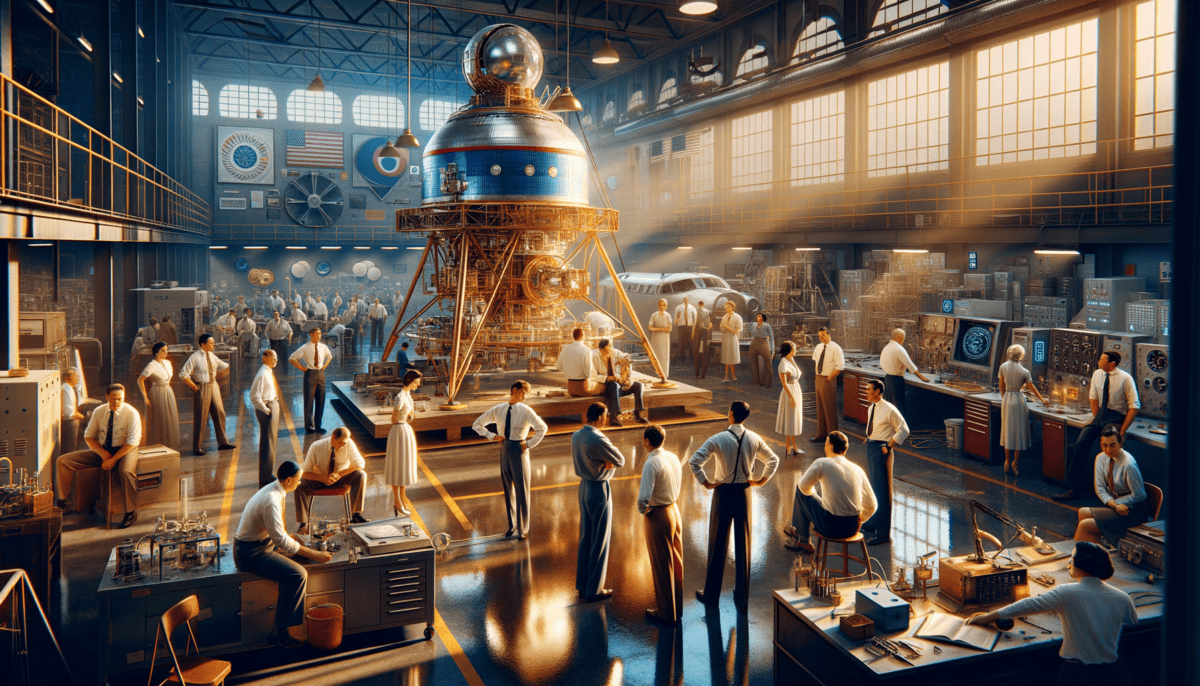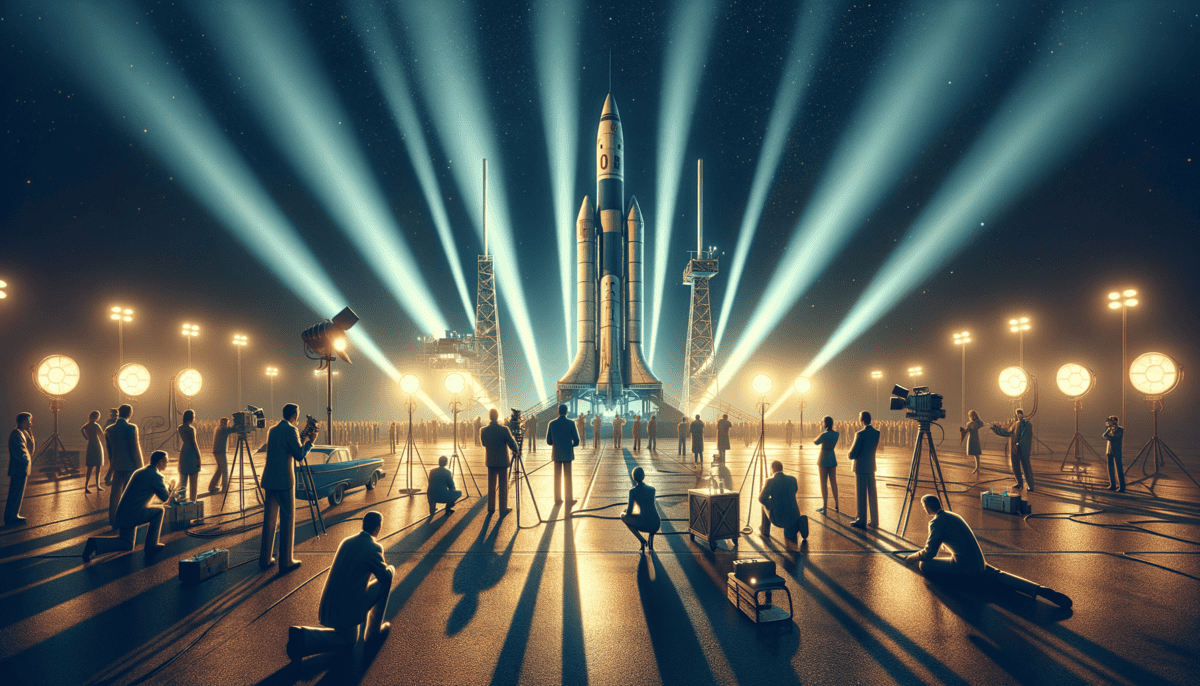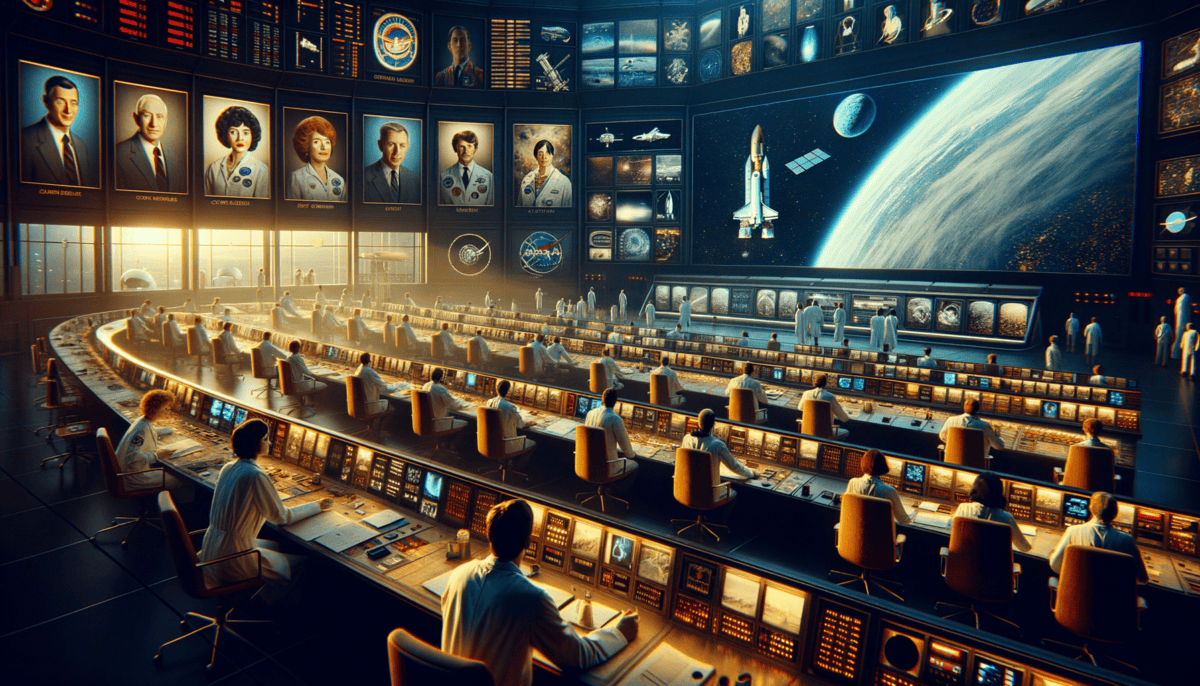The Race Begins
It was a cold October night in 1957 when everything changed. Tommy sat on his front porch with his dad, looking up at the stars. They were doing their usual stargazing when his father pointed to something moving across the night sky.
"Look, son! That's Sputnik – the Russian satellite!" Dad said, his voice filled with worry. "The Russians beat us to space!"
Tommy had never seen his father so concerned. At school the next day, everyone was talking about Sputnik. His teacher, Ms. Thompson, explained that the Soviet Union (which people called Russia) had launched the first human-made object into space.
America Gets a Wake-Up Call
"We must catch up!" became the cry across America. President Eisenhower knew the United States needed to show it could also reach for the stars. He called together the smartest scientists and engineers in the country.
“We need our own satellite,” the President announced. “And we need it fast!”
At the Jet Propulsion Laboratory (JPL) in California, a special team came together. They were like superheroes, but instead of capes, they wore white lab coats and carried calculators.
Meet the Space Team
Dr. William Pickering led the team. He was like a coach, making sure everyone worked together. Dr. James Van Allen was the curious scientist who wanted to learn about space. And Dr. Wernher von Braun knew all about rockets.
Tommy followed the news every day. His class started learning more about space:
• Satellites can orbit Earth like the moon
• Space is very, very cold
• Rockets need lots of fuel to reach space
• Scientists work together to solve big problems
A Big Challenge
Building a satellite wasn't easy. The team had to work fast but be careful. One small mistake could ruin everything. They named their satellite "Explorer 1" and hoped it would help America catch up in the space race.
"Why is it so important?" Tommy asked his dad one evening.
"Son," his father replied, "this isn't just about being first. It's about showing what Americans can do when we work together. It's about exploring new frontiers and learning about our world."
The whole country watched and waited. Could America's scientists and engineers build a satellite that would work? Would Explorer 1 make it to space?
Getting Ready ️
In workshops and laboratories, the team worked day and night. They built special tools and tested their ideas. Some days were good, with lots of progress. Other days brought problems they had to solve.
"Each failure teaches us something," Dr. Van Allen told his team. "We learn and try again."
News reporters came to JPL every day, asking questions:
- "When will it be ready?"
- "Will it really work?"
- "Can America catch up?"
The scientists kept working. They knew they weren't just building a satellite – they were making history. Every bolt, every wire, every calculation had to be perfect.
Hope for Tomorrow
As 1957 turned into 1958, excitement grew. Explorer 1 was almost ready. The team checked everything twice, then checked again. They couldn't wait to show the world what American science could do.
Tommy and his classmates made a model of Explorer 1 for their science fair. "Maybe someday," Tommy thought, "I'll help build real spaceships!"
The race to space wasn't just about beating the Russians anymore. It was about reaching for the stars, about learning new things, about showing what people could achieve when they worked together.
At JPL, the team put the finishing touches on Explorer 1. Soon, very soon, they would try to launch their creation into the sky. America held its breath, waiting to see if Explorer 1 would fly.
The Brilliant Minds
Dr. James Van Allen sat at his desk, staring at drawings of Explorer 1. He wanted to learn about space in a new way. His special instrument would ride inside the satellite to find out what was up there.
The Space Detective ️
“What secrets are you hiding?” Dr. Van Allen whispered, looking up at the sky through his office window. He had spent years studying space, but there was still so much to learn.
His assistant knocked on the door. “Dr. Van Allen, the team is ready for the meeting!”
Building the Future ️
At JPL, scientists worked with big pieces of metal and tiny wires. They were making Explorer 1 piece by piece. It had to be strong enough for space but light enough to fly.
“Think of it like building the world’s most special toy,” explained Dr. William Pickering to a young visitor. “Every part must fit just right.”
The team faced big problems:
- Making Explorer 1 small but strong
- Keeping it safe from space’s cold and heat
- Making sure it could talk to Earth
- Getting it to fly high enough
- Helping it stay in space
Smart Ideas Come Together
Dr. Van Allen’s special tool was a Geiger counter. It could count tiny bits of energy in space. No one knew what it would find!
“What if we find something new up there?” one young scientist asked.
“That’s why we explore,” Dr. Van Allen smiled. “To find things we don’t know about yet.”
Team Spirit
Everyone at JPL worked together like a big family. Some people made drawings. Others built parts. Some wrote special math problems to help Explorer 1 fly right.
“Remember,” Dr. Pickering told his team, “we’re not just building a machine. We’re building America’s first step into space!”
Getting Ready for Space ⭐
As days passed, Explorer 1 started looking more like a real satellite. It was shiny and silver, with special parts that would open up in space.
“Will it really work?” asked Tommy, who was visiting JPL with his school class.
“We’ve done our very best,” said Dr. Van Allen. “Now we have to trust in science – and a little bit of luck!”
The Final Touches
The team painted special numbers on Explorer 1’s side. They added Dr. Van Allen’s instrument and checked all the connections. Every wire, every screw, every part had to be perfect.
“It’s like packing for a very long trip,” one engineer explained to the students. “We can’t forget anything because we can’t fix it once it’s in space!”
• Space has no air
• It’s very cold AND very hot
• Things float because there’s no gravity
• Satellites must go very fast to stay in orbit
• Space is bigger than we can imagine
Ready for History
As Explorer 1 got its final checks, excitement filled the air at JPL. Dr. Van Allen’s special tool was ready to look for space secrets. The rocket team in Florida was getting ready too.
“Soon,” Dr. Pickering told everyone, “we’ll be part of something that’s never been done before in America.”
Tommy and his classmates made a promise to watch the launch on TV. Maybe someday they would build space machines too! The whole country waited to see if America’s first satellite would fly into the stars and make history.
Building the Dream
The sun rose over JPL as teams of scientists rushed to finish Explorer 1. Time was running out! They had to get everything perfect before the big launch.
The Perfect Fit
“Careful with that part!” called Dr. Pickering. “It’s like putting together a puzzle where every piece must be just right.”
The satellite was small – only 80 inches long. That’s about as tall as a grown-up! But it had to hold lots of important things inside.
Space Problems, Smart Solutions
The team faced tricky problems every day:
- Making parts that work in super hot and cold space
- Finding ways to keep the satellite light
- Building antennas that could talk to Earth
- Making sure nothing would break during launch
- Testing everything over and over
Testing Time
“What happens if it gets too cold?” asked Sally, a young engineer.
“That’s why we test!” smiled Dr. Van Allen. They put Explorer 1 in special rooms that were very cold, then very hot.
“Every test helps us learn something new,” Dr. Pickering explained. “And every lesson makes Explorer 1 better!”
Working Together
Everyone had a special job. Some people made tiny electronic parts. Others wrote down numbers and did math. Some checked every piece with special tools.
Almost Ready!
Days turned into weeks. Explorer 1 started looking more complete. Its shiny surface sparkled under the lab lights.
“Look how beautiful it is!” said Tommy, visiting again with his class.
“Yes,” said Dr. Van Allen, “and soon it will be even more beautiful floating among the stars!”
Final Countdown ⏰
The last days were super busy. Teams worked day and night to finish everything. They made lists and checked them twice:
✓ All parts secure
✓ Instruments working
✓ Radio signals strong
✓ Power systems ready
✓ Everything clean and perfect
The Big Move
Finally, it was time to pack Explorer 1 for its trip to Florida. They put it in a special box with soft padding.
“Like tucking a baby into bed,” laughed one engineer.
“A baby that’s going to space!” added another.
Hope and Dreams
As Explorer 1 left JPL, everyone felt proud and nervous. They had worked so hard. Now their creation would travel to Florida for its big moment.
“Will we really make history?” asked Sally.
“We already have,” smiled Dr. Pickering. “Now let’s see if we can touch the stars!”
The whole team watched as their precious satellite drove away. Soon it would be time for the most exciting part – the launch into space! Everyone crossed their fingers and hoped for the best.
The Final Hours
The Cape Canaveral sky glowed orange as Explorer 1 sat ready on its launch pad. Teams of people rushed around, checking everything one last time.
A Special Morning
Dr. Pickering looked up at the tall rocket. “Today’s the big day!” he said with a smile that showed both excitement and worry.
Tommy and his classmates stood behind a fence, watching with wide eyes. They had special passes to see the launch!
Last-Minute Checks
“Is everything ready?” Dr. Van Allen asked, looking at his clipboard.
Sally nodded, “The satellite is perfect! We checked it three times this morning.”
“When you’re sending something to space, you can never check too many times,” Dr. Pickering reminded everyone.
Weather Worries ⛅
The team watched the sky carefully. They needed perfect weather for the launch.
“Look at those clouds,” worried one engineer. “Will they cause problems?”
“The weather team says they’ll clear up soon,” another answered hopefully.
The Control Room ️
Inside a special building, people sat at desks full of buttons and screens. Each person had an important job:
- Weather watchers
- Rocket checkers
- Radio listeners
- Safety guards
- Launch controllers
Getting Ready
The hours felt like days. Everyone moved carefully but quickly.
“Remember,” said Dr. Van Allen, “we’re about to do something no American has done before!”
The team followed their checklist:
✓ Fuel tanks filled
✓ Radio signals clear
✓ Safety systems on
✓ Launch pad clear
Special Visitors
Important people from Washington came to watch. They wore fancy suits and carried cameras.
“The whole country is watching,” one visitor said. “This is a big moment for America!”
Almost Time! ⏰
The sun started to set. Bright lights turned on around the rocket.
“It looks like a giant Christmas tree!” Tommy whispered to his friends.
Dr. Pickering gathered his team. “Whatever happens tonight, I’m proud of all of you.”
The Wait
Everyone found their spots. Some went to the control room. Others stood at safe watching areas.
Sally held her breath. “Just a few more minutes,” she thought.
The rocket stood tall and proud against the dark sky. Soon it would try to carry Explorer 1 into space. Would everything work? The whole team hoped their hard work would pay off.
A Historic Night
The big moment had arrived! The rocket stood tall against the dark sky, ready to carry Explorer 1 to space.
The Launch Begins!
“Ten… nine… eight…” The countdown echoed through speakers. Everyone held their breath.
“Seven… six… five…” Tommy squeezed his friend’s hand tight.
“Four… three… two… one… LIFTOFF!”
Fire and Light
Bright flames shot from the bottom of the rocket. The ground shook!
“Look at it go!” shouted Sally, pointing up.
“It’s like a giant firefly climbing into the sky!” Tommy said with wonder.
Going Up, Up, Up! ⬆️
The rocket moved slowly at first. Then it went faster and faster.
“Everything looks good!” called out Dr. Pickering from the control room.
The rocket climbed higher until it was just a bright dot in the night sky.
Waiting for News
Now came the hard part – waiting to hear from Explorer 1.
“Listen carefully,” Dr. Van Allen told his team. They all wore headphones.
The First Signal
Minutes felt like hours. Then…
“I hear it!” shouted Sally. “Beep-beep! Beep-beep!”
The room burst into cheers! Explorer 1 was in space and working!
Amazing Discovery
As Explorer 1 flew around Earth, it found something nobody knew was there.
“Look at these readings,” Dr. Van Allen said excitedly. “There are special bands of energy around Earth!”
These bands would later be named the Van Allen Belts.
- Explorer 1 circled Earth every 115 minutes
- It flew 1,594 miles above our planet
- It sent back important space facts
- It showed America could reach space
- It helped us learn about our planet
Happy Scientists
Dr. Pickering, Dr. Van Allen, and the whole team smiled and hugged.
“We did it!” they cheered. “America is now in space!”
A Special Night
Tommy couldn’t sleep that night. He kept thinking about the rocket and Explorer 1.
“Maybe someday I’ll help build spaceships too,” he thought.
The stars seemed to twinkle brighter that night. Among them, America’s first satellite, Explorer 1, was making history with every beep.
The Space Age Begins
Explorer 1 changed everything! It showed the world that America could do amazing things in space.
Making History Every Day
Tommy ran to school excited every morning. His teacher, Ms. Wilson, had a special space board where they tracked Explorer 1’s path.
“Our satellite has gone around Earth more than 100 times!” Ms. Wilson announced proudly.
New Dreams Take Flight ✨
“I want to be a space scientist!” Sally told her class during show-and-tell.
“Me too!” said many other kids.
“Explorer 1 showed us that dreams can come true if we work hard,” Dr. Van Allen told the students during a special visit.
More Missions to Come
NASA started planning lots of new space missions. They wanted to:
- Send people to space
- Learn about other planets
- Take pictures of distant stars
- Build bigger rockets
- Make space stations
A Special Museum Display ️
Today, you can visit Explorer 1 in a museum! It helps us remember that special night in 1958.
“Look, that’s our satellite!” Tommy told his little sister years later. “I saw it go up into space!”
The Story Lives On
The story of Explorer 1 still makes people smile. It shows that big dreams can come true.
“Remember,” Dr. Pickering often said, “space is for everyone who dares to explore.”
Looking to the Stars
Every night, kids like Tommy and Sally look up at the stars. They dream about space just like the Explorer 1 team did.
“What will we find next?” they wonder.
The answer is up there, waiting to be discovered by brave explorers like you!
A New Beginning
Explorer 1 wasn’t just America’s first satellite. It was the start of something bigger.
Today, we have hundreds of satellites in space. They help us:
– Watch TV
– Use phones
– Check the weather
– Learn about Earth
– Talk to people far away
It all started with one brave little satellite named Explorer 1, reaching for the stars and showing us what was possible.






